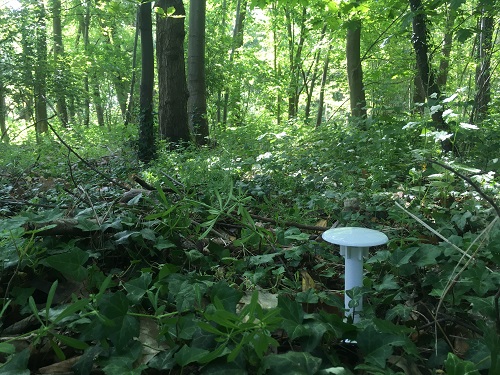User Story: Mapping thermal buffering capacity of European forests

Published on 27/06/2024
Unravelling Thermal Buffers
Scientists studying the environment frequently rely on macroclimatic data derived from standardised measurements in weather stations. However, these weather stations are designed to avoid the influence of external variables such as vegetation cover or topography on these measurements. They miss out on what is really important for many species living close to the ground, also known as the microclimate. A good example of this discrepancy is the temperature difference within and outside a forest during a scorching summer heatwave. This temperature difference, also called thermal buffering, is caused by the shading of the leaves of trees and the photosynthesis process (trees absorb water from the soil and transpire this, resulting in a natural cooling system).
The research lab sGlobe of the KU Leuven [1], led by Prof. Koenraad Van Meerbeek, aims to unravel the drivers and impact of microclimate conditions. The lab has developed new data that accounts for the thermal differences inside and outside forest ecosystems. By doing so, the lab gains insights into the actual temperature conditions experienced by forest organisms, including plant species, insects, and butterflies. Ultimately, this approach allows for a more accurate assessment of the impact of climate change on these species.
Dr. Stef Haesen (sGlobe, KU Leuven): “Each species thrives under certain environmental conditions. If we would model the optimal temperature conditions for a certain forest plant species based on macroclimate data, we might believe that it could survive up to a maximum temperature of, for example, 30 degrees Celsius. However, if we correct for the temperature buffering effect of the forest, we would know that the species only survives up to a temperature of 25 degrees Celsius. Understanding this mismatch is crucial for accurately mapping the spatial distribution of species across Europe and is vital for effective conservation planning for these species."

Big Data in microclimate studies
To study microclimate ecology and global change effects, sGlobe combines big data with state-of-the-art modelling techniques like machine learning and species distribution modelling (SDM) to extract patterns from the data and answer ecological questions on large spatial scales (ecoinformatics).
The study of dr. Stef Haesen was a huge collaborative effort combining data from 52 researchers from over 13 countries [2]. A lot of researchers are already measuring microclimate conditions within local areas. Dr. Jonas Lembrechts brought all of these smaller datasets together within one big database called SoilTemp [3]. dr. Stef Haesen: "We selected different locations from this database where people were already measuring microclimate temperatures inside forests. In this way, we gathered more than 24000 measurements across more than 1200 European locations, spanned from Portugal to Finland."
Modelling for conservation
Today, the capabilities of our laptops simply can't keep up with the exponential growth of big data. Leveraging high-performance computing is essential if you want to fully utilise big data with all the extensive information it offers.
Dr. Stef Haesen (sGlobe, KU Leuven): “Through modelling, we aimed to predict the thermal buffering capacity of European forests at a high spatial resolution of 25 x 25 m². This means that our study area consisted of more than 3 billion pixels, of which the monthly microclimate temperature had to be predicted individually. Reaching this objective without the computational capacity available at the Vlaams Supercomputer Centrum would have been impossible.”
The lab used a combination of tiling and parallelisation within the cluster. Dr. Stef Haesen (sGlobe, KU Leuven): “Europe is so big that trying to predict everything at once just isn't practical. We divided the area into approximately 1,400 smaller, manageable tiles to manage this. We then used the nodes in the Genius cluster—specifically, its 36 cores allowed us to process 36 tiles concurrently. As each tile was completed, we immediately commenced processing on the next, maintaining continuous parallel computation. This approach significantly accelerated our analysis.”
The modelling shows the differences in Europe depending on the latitude. Dr. Stef Haesen (sGlobe, KU Leuven): “In the Mediterranean region, for example, we mostly see that forests are hotter. We believe it's due to the sparse canopy because different tree species appear there than here in Flanders. From southern France up to Germany, we have temperate forests with cooler temperatures in summer and warmer temperatures in winter. The Boreal forests in Scandinavia are coniferous forests. There in winter, it’s a lot warmer inside the forests than outside.”
From Data to Decisions
Dr. Haesens's research generates ecologically relevant microclimate data: “I personally analysed the spatial distributions of forest plant species across Europe, comparing traditional climate data with our high-resolution microclimate data. We observed a contraction of these species’ geographical range along the latitudinal gradient, indicating that traditional data tends to overestimate the southern and northern limits where species can be found.”
His research is used by ecologists in Belgium and all over Europe to gain better insights into the distribution of forest plant species and the current biodiversity crisis. For instance, researchers from Ghent University used the data to correct the thermal niches of forest plants, and a study by Italian researchers [4] looked at how flowering times of plants growing under forest trees change with warmer temperatures and different amounts of light in Italian forests.
In another PhD project at the sGlobe lab, Xiaqu Zhou is using the data to identify microrefugia in European forests. These locations in the landscape shelter populations from climate change and support the long-term persistence of organisms beyond their main distribution ranges. In collaboration with Ghent University, the generated insights resulted in an article in NatuurFocus informing and advising forest managers and policymakers.
Besides ecoinformatics, sGlobe also conducts fieldwork and flies with drones to collect primary ecological data in natural and anthropogenic systems to gain insights into the current biodiversity crisis. In Meerdaal forests, there is a large network of microclimate sensors.
Research Efficiency thanks to VSC supercomputing
Dr. Stef Haesen (sGlobe, KU Leuven): “In our division, we were pioneers in using supercomputing infrastructure despite our limited experience and high-performance computing skills. Thankfully, the VSC support team was incredibly supportive, answering all our questions. I would definitely recommend the services and infrastructure of the Vlaams Supercomputer Centrum. Using VSC infrastructure allowed us to accomplish our research in just one and a half months, which would have otherwise taken four years. This efficiency was crucial for our project's success.”
[1] sGlobe lab was founded by Prof. Van Meerbeek in 2018. More info: https://www.sglobelab.com/
[2] Belgium, France, Australia, Czech Republic, United Kingdom, Switzerland, Italy, Slovakia, Sweden, Germany, the Netherlands and Spain
[3] More info: https://www.soiltempproject.com/

prof. Koenraad Van Meerbeek
Koenraad Van Meerbeek is an associate professor at the Division of Forest, Nature, and Landscape at KU Leuven in Belgium. After earning his master's degree in Bioscience Engineering, he spent 1.5 years as an environmental consultant before returning to academia as a PhD researcher at KU Leuven. In 2015, he secured funding to continue his research as a postdoctoral fellow at KU Leuven. Two years later, in 2017, he moved to Denmark to work with Professor Jens-Christian Svenning at Aarhus University. By the end of 2018, Koenraad returned to KU Leuven, where he was appointed Assistant Professor. Since then, he has established the sGlobe lab and developed his own research initiatives, focusing on the conservation of plant biodiversity and the impacts of climate change on plant species and ecosystem functionality.

dr. Stef Haesen
Stef Haesen is a postdoctoral researcher at the Division of Forest, Nature, and Landscape at KU Leuven in Belgium. His main research interests lie in ecology, climate change, biogeography, and associated modeling techniques. After completing his bachelor's and master's studies within the faculty of bioscience engineering, he started his PhD in 2019. Central to his research is the question whether microclimates are able to improve species distribution models for forest plant species. In this way, he aims to enhance our understanding of how microclimates influence plant species distributions and the broader implications for biodiversity conservation in the face of climate change.